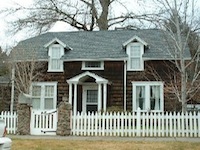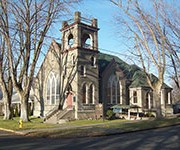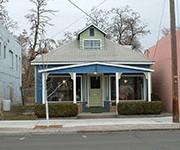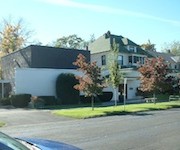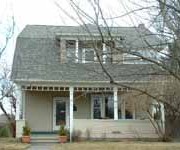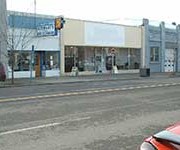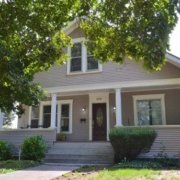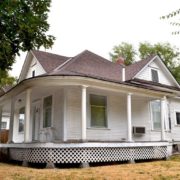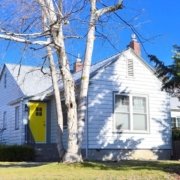History of 827 Hobson Street, Walla Walla, WA
Legal Description:
The East 13.2 feet of Lot 6 in Block 2 of Isaacs’ Second Addition to the City of Walla Walla, lying South of the Southerly line of the Bulkhead on the Southerly side of Mill Creek. Also, Lot 1 in Block 3 of Isaacs’ Second Addition to the City of Walla Walla, Washington, according to the official plat thereof of record in the office of the Auditor of Walla Walla County, Washington.
Title History:
Walla Walla was originally laid out by surveyor H.H. Chase in 1859, even before its formal incorporation as a city in 1862, as a one quarter square mile oriented N-S, E-W with its eastern side centered on the point where Main Street crossed Mill Creek (at roughly the point where it does now). To this original area, additional parcels were annexed from time to time, usually with the name of the land owner of record at the time the additions were made. The first recorded transaction for 827 Hobson happened on January 20, 1864 when William H. Patten and Elizabeth A. Patten sold an 80 acre parcel in the SW Corner of the NW Quarter of the SW Quarter of section 21 in Township 7 to H.P. Isaacs and Lucie Isaacs for $2000. 827 Hobson is located in Isaacs Second Addition and is one of several areas in the central part of Walla Walla that Isaacs developed. The involvement of the Isaacs family with the installation of a water system in Walla Walla, among other very important projects, included 827 Hobson. H.P. and Lucy Isaacs conveyed a deed for $10,000 to their son J.C. Isaacs for the “right to take and conduct away the subterranean waters in order to supply the inhabitants of Walla Walla with water via ditches and a reservoir with the promise that “no buildings, fruit or shade trees or growing crops be interfered with.” Besides the water system, H.P. Isaacs was influential in the development of Walla Walla as a wheat growing area. Lyman in his History of Walla Walla County states that Isaacs “demonstrated to the farmers that wheat could be produced profitably on the hills and uplands which in those early days had been given over to stock-raising.” He built numerous flour mills throughout the Northwest and he found markets for wheat in the Orient, especially China. The Isaacs home is 100 Brookside Drive which began as a small adobe house in 1865 which was then incorporated into their Queen Anne mansion in 1886. It is thought to be the oldest house in Walla Walla, other than the 1858 officers homes at Fort Walla Walla, now the Veterans Administration Medical Center.
On March 28, 1896 a warranty deed for several Isaacs parcels including Isaacs Second Addition was conveyed from the Isaacs to Miles C. Moore, W.W. Baker, and H. C. Baker for $20,000. This deed provided for more water rights, land for streets, and flumes for flour mills, preliminaries for the establishment of residential areas. On November 28, 1899, Moore and the Bakers deeded these rights to the City of Walla Walla.
H.P. Isaacs died in 1900 intestate (he had no will) which necessitated several legal actions to settle his estate. Quit claim deeds were filed by H.P.’s heirs sorting out parcels amongst them since that had not been decided by their father. In 1901 the heirs of William and Elizabeth Patten and the Isaacs heirs dealt with a “fatal defect” in the deed filed in 1864 for the first transaction for the 80 acre parcel. Elizabeth Patten had not signed that deed! And in 1927 a man named J.C. Thomas filed an affidavit stating he was a U.S. Citizen, over 21 and capable of being a witness for one of the Quit Claim deeds filed in 1902 between Lucy Isaacs and her children. That deed, 25 years later, included lot 1, Block 3 of Isaacs Second Addition.
On April 2, 1901 an ordinance was passed “specifying a route through which the waters flowing from the Isaacs Mill Race shall pass for city purposes and grants the right to the city to maintain it and monitor individual use of that water by those who build along Mill Creek.” This, of course, pertains to 827 Hobson’s location on Mill Creek. It was 1947 before the current concrete channel was constructed, improving upon the one installed in 1938.
On February 7, 1901 C.E. Griffith and Alveretta B. Griffith purchased lots 1 and 2 of Block 3 of Isaacs Second Addition for $700. The Griffiths took out a mortgage for $1000 on February 10, 1902 which must have been used to build a house because the 1902 City Directory lists Charles E. Griffith as a pawnbroker with a business address of 10 N. Third and residence at Hobson and Clinton, suggesting that the Griffiths built the first house at 827 Hobson in 1902. The 1905 Sanborn Fire Map shows a much smaller structure than is there now, along with a creek side structure assigned the address of 827 ½ Hobson far back on the lot. Two very small “outbuildings” are also shown on the fire map. According to recent research and excavations conducted by a Whitman student of areas that had been the sites for “outhouses/latrines.” 827 ½ Hobson may have been the living quarters for the Griffiths while their permanent home was being built.
The Griffiths, like several successive owners, did not own this property long and prices had an unexplainable fluctuation mainly downward. Until a 1906 transaction, the property included Lot 2 which is now 833 Hobson. On August 8, 1902, the Griffiths sold to Elmer V. Chase, a bachelor, for $2500. Chase then sold the property to W.C. Bennett and Lizzie Bennett on February 25, 1903 for $2000. Bennett is listed in the 1904 City Directory as a horse dealer. On November 18, 1904 the Bennetts sold to C.E. Freeburn and Jennie Freeburn for $1450. On March 13, 1905, the Freeburns sold to John T. Puckett and Mary Puckett for $1550. Puckett is listed in the 1907 City Directory as “operator Evening Bulletin” which was located on 4th and Alder and advertised as “a newspaper that stands for a Square Deal” with subscriptions available for 40 cents a month. On November 3, 1906 the Pucketts sold only Lot 1 to R.W. Fisher and Emma U. Fisher for $2250. Fisher obviously worked with Puckett as the 1909 City Directory listed him as the City Editor of the Evening Bulletin. The only existing building permit shown for 827 Hobson was granted to Fisher on March 30, 1916 for garage improvement for $75. The Fishers lived here until 1937 when they sold to J.E. Martin and Claire Martin for a stated consideration of $10.00 on May 27, 1937. The 1937 City Directory lists Joseph E. Martin as the General Manager of the Walla Walla Valley Railway. On April 25, 1941 for a consideration of $10.00 the Martins sold to Albert E. Heric and Nellie M. Heric. Albert Heric was listed as Walla Walla’s Assistant Postmaster in the 1941 City Directory and then as Walla Walla’s Postmaster in the early 1950’s. On September 26, 1955 the Herics sold to George N. Beito and Winifred E. Beito for $12,000. George Beito was a physician at the Veterans Administration Hospital. As was typical of the 1950’s City Directories, the Beitos are listed as owning a 1952 Chevrolet for several years George Beito died in 2002. Winifred Beito was interviewed and described the changes that the Beitos made to the house. Their remodeling included interior rearrangement of rooms and halls. As an example, the upstairs master bedroom was divided into two bedrooms. On the first floor a hallway was created to give another access to the kitchen. They also acquired the 13.2 foot parcel from the owners of lot 6 in Block 2 in the back of their property to install a fence along the west side of the property of this very large lot which is 313 feet deep and 90 feet wide.
In September of 1997, the Beitos sold 827 Hobson to Beth Hudson, Reference Librarian at the Walla Walla Public Library, and John Christy, Correctional Officer at the Washington State Penitentiary for $135,500. They have created “street appeal” in the front with their magazine-quality garden bordering the front entrance sidewalk, installation of a white picket fence, and a colorful front door. A newly installed french door now leads from the kitchen eating area to the large backyard which they are developing.
Construction of the house
Based on the City Directory of 1902, amounts of money involved in the mortgage of that year, and the 1905 Sanborn Fire Map, it appears that a smaller dwelling than is now there was built as the home of Charles E. Griffith and Alveretta Griffith at 827 Hobson in 1902. The Sanborn Fire Map has a “pasteover”( it was revised until 1948) right over the smaller dwelling which would indicate that it was the core of the current structure. No building permit exists for the enlargement of the house from late 1907 when a full record of permits exist to the 1930’s, but the same drawings of the house as in the pasteover from the 1905 fire map are shown on the 1931 revision and the 1948 revision of the Sanborn Fire Maps, so remodeling must have occurred prior to 1931. The county assessor lists the construction date as 1905, though those records are very often inaccurate. Because R.W. and Emma U. Fisher purchased the property in late 1906 for $2500, indicating enlargement had not yet taken place, and no building permit for the enlargement is shown for late 1907 to 1931, it is likely that the enlargement was done by the Fishers in late 1906 or early 1907. Therefore, the conclusion is that 827 Hobson was originally built in 1902 by Charles E. Griffith and Alveretta Griffith, and enlarged to its present shape circa 1907.
References:
Pioneer Title Company documents for this property
Sanborn Fire Maps available at the Whitman College Archives and the Walla Walla Public Library
Walla Walla County Assessor’s Office
Walla Walla City Directories beginning in 1880 (although not available for all years) available in the Whitman College Archives and the Walla Walla Public Library
Whitman College Archives, Larry Dodd, Archivist, for building permits file, Sanborn Fire Maps, newspaper files, etc.
Katherine Weingart Walla Walla 2020 Research Service P.O. Box 1222 Walla Walla, WA 99362 September 2002

